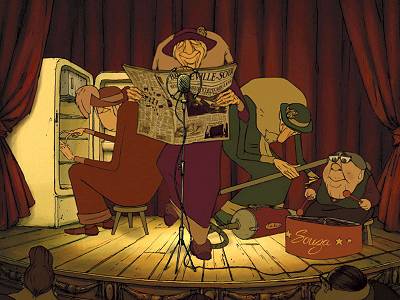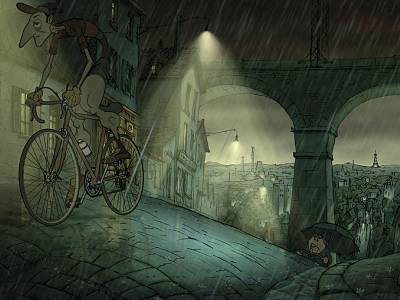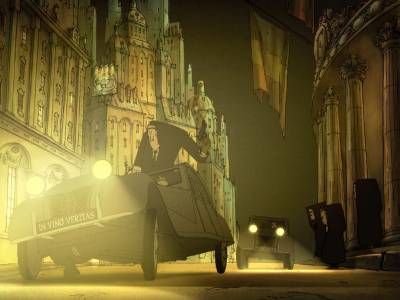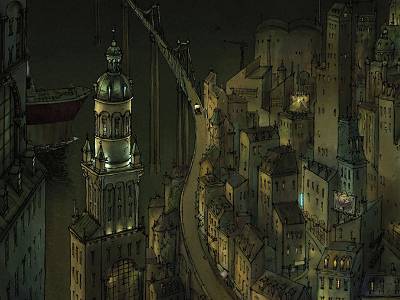Belleville Rendez-vous
Lovely French animation that finally provides the Tour De France / Mafia crossover we've been waiting for.

What to say about this that the above capsule and screenshots do not? In Belleville Rendez-vous director and writer Sylvain Chomet has created a highly individual, charming and stylish shaggy dog story that ought to have universal appeal and do a little more PR work for the notion that not all animation can only be enjoyed by children.
The film opens with the singling triplets act that gives the movies its original French title, Les Triplettes de Belleville in their 30's heyday. The animation itself reflects the animation of the times, with the black and white style reminiscent of the early Felix The Cat and Steamboat Willy works. It's also an effective introduction to Chomet's quirky character design and bizarre sense of humour. In the first ten minutes you'll see old men turn into monkeys and start to steal the bananas a semi-naked black chick is using to cover her modesty and Fred Astaire's tap shoes come alive and eat him. Right... Despite some abstract images the speedy pacing somehow makes it feel far more conventional, as oddities are rarely dwelt on for any length of time.
The film then deals with a unhappy child, Champion, who's being looked after by his grandmother Madame Souza after the presumable death of his mother and father, who are only present in a picture on Champion's wall. After trying unsuccessfully to cheer Champion up with a faithful hound named Bruno, she notices Champion's growing obsession with cycling. Buying him a tricycle soon puts a smile on the little tykes face.

Years pass, the countryside their house resides in gives way to the urban sprawl and a railway line now rather inconsiderately runs next to Madame Souza's house. Ever since a toy train ran over Bruno's tail he's harboured a hatred of trains that can only be expressed by barking, and as train services are frequent and reliable pretty much everywhere outside of Britain you'll hear a lot of Bruno's bark. Somehow it doesn't become too annoying, which is surprising but welcome. Champion has been trained with skill by Madame Souza, as can clearly be seen by his ridiculously developed leg muscles. Chomet's character design is distinctive and remarkable which stamps personality all over the work that gives the movie a charm that ought to appeal even to those not given to enjoy any animated feature.
Champion enters the premier cycling tournament, the Tour De France, but his participation is cut short by the fiendish machinations of the French Mafia. They sabotage Madame Souza's support truck and kidnap Champion and two other participants. Once Madame Souza fixes the vehicle with the impromptu and hilarious use of Bruno as a temporary tyre, they set about tracking him down with Bruno's keen sense of smell. The trail takes them to the sprawling metropolis of Belleville, which is heavily inspired by New York. If the stylised Statue of Liberty wasn't a give away, the presence of a large number of very large people perhaps is.
Madame Souza and Bruno struggle to survive in a city with no money or shelter, but a fortuitous encounter with the now elderly singing triplets provides her with allies. Despite falling on hard times and having to exist purely on a diet of frogs, they continue making music with pretty much anything they can get their hands on. Newspapers, teapots, bike wheels, refrigerators - anything capable of having a tune played on it will be used. Music is essential to the triplets and so it's essential to the story, so it's a good thing that Beno?t Charest and Mathieu Chedid have done a sterling job in putting together an immaculate soundtrack.

They rather bravely hatch a plan to infiltrate the Mafia's building and their omnipresent security, large suited men with broad, square shoulders and a finger always near the trigger of their handguns. They seem to have been styled on Ikea wardrobes, but their bosses are more along the traditional image of an elderly French drunk, hangdog face and swollen noses. They bust out prompting a surreal car chase through the mean streets of Belleville that's well handled, but not one to challenge The Castle Of Caglistro's title of best animated chase sequence.
As mentioned before, Chomet's style is distinctive indeed and the only comparisons I can make are with the World Record short from The Animatrix and possibly Aeon Flux. Motions have been captured fluidly as Western animators follow in the footsteps the Japanese have laid out by mixing 3D elements along with the traditional cel animations. While the examples here don't achieve the seamlessness of that achieved by Rintaro's jaw-dropping adaptation of Osamu Tezuka's Metropolis, it's superior to most of Disney's attempts and on a par with earlier examples such as Blood: The Last Vampire and Ghost In The Shell.
If you're the kind of person who doesn't like reading subtitles, don't worry - there are none. If you're the kind of person that despises dubs, don't worry - it isn't. While some French dialogue is heard in passing moments, such as television snippets, there is no dialogue of consequence. The story unfolds purely through the action and the expressive qualities demonstrated both by Madame Souza and Bruno. Such a structure, even with a comparatively simple if obscure story such as this is always a difficult trick to pull off but Chomet acquits himself admirably and should be rightfully proud of his creation. Certainly the plaudits earned at the Cannes film festival are more than justified.

If there's any moral or message in the film it's well hidden or subtle to the point of vanishing, and that's about as large a nit as I can pick with it. It's unfair to pillory this particular film for it, but anyone not familiar with the intricacies and grander thought provoking concepts that animation can portray will leave the cinema with no notion that the genre can provide them. It's a very enjoyable yarn, but that's all it is. However, those dismissive of animation in general are broadly those that don't want to have any thoughts provoked so perhaps it all evens out in the end.
It's not Chomet's duty to go beating a propaganda drum in his work, just to provide an enjoyable and successful tale. He's achieved in great style indeed. I feel it's missing the spark to make it a true classic but there really are few bones to pick with the story or the telling. If you've a passing interest in animation or cinema in general you owe it to yourself to see this on it's limited cinema run if humanly possible. You won't be disappointed.
Were I in the business of passing quantifiable judgements, I'd award this 4/5 TippyMarks.
Jean-Claude Donda
Michel Robin
Monica Viegas